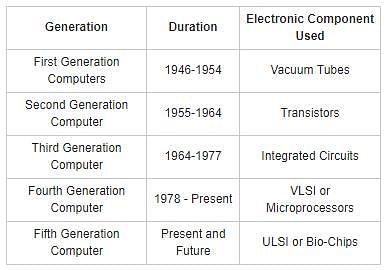Railways Exam > Railways Questions > Which electronic components were used in Fift...
Start Learning for Free
Which electronic components were used in Fifth Generation Computers?
- a)Transistors
- b)Integrated Circuits
- c)VLSI
- d)ULSI
Correct answer is option 'D'. Can you explain this answer?
| FREE This question is part of | Download PDF Attempt this Test |
Verified Answer
Which electronic components were used in Fifth Generation Computers?a)...
Fifth Generation (Present and Future):
- 5th generation computers use ULSI (Ultra-Large Scale Integration) chips
- Millions of transistors are placed in a single IC in ULSI chips
- 64-bit microprocessors have been developed during this period
- Memory chips and flash memory up to 1 GB, hard disks up to 600 GB & optical disks up to 50 GB have been developed
- Fifth generation computing devices, based on Artificial Intelligence, are still in development, though there are some applications, such as voice recognition, that is being used today
Notes:


Most Upvoted Answer
Which electronic components were used in Fifth Generation Computers?a)...
The correct answer is option 'D' - ULSI (Ultra Large Scale Integration).
Fifth generation computers were developed in the 1980s and were characterized by their use of ULSI technology. ULSI refers to the integration of a very large number of transistors and other electronic components onto a single chip. This allowed for significant advancements in computing power and efficiency.
Here is a detailed explanation of the electronic components used in fifth generation computers:
1. Transistors:
- Transistors are electronic devices that can amplify or switch electronic signals and electrical power.
- They were the basic building blocks of early computers and were used for logic gates, amplifiers, and switching circuits.
- Transistors were first used in the second generation of computers and played a key role in the development of subsequent generations.
2. Integrated Circuits:
- Integrated circuits (ICs) are small electronic circuits that are fabricated onto a single semiconductor material, usually silicon.
- ICs consist of multiple electronic components such as transistors, resistors, capacitors, and diodes, all interconnected on a single chip.
- They were introduced in the third generation of computers and greatly increased computing power and reduced the size of electronic devices.
3. VLSI (Very Large Scale Integration):
- VLSI refers to the integration of a large number of transistors and other electronic components onto a single chip.
- It allowed for the creation of more complex and powerful circuits.
- VLSI technology was used in the fourth generation of computers and paved the way for the development of microprocessors.
4. ULSI (Ultra Large Scale Integration):
- ULSI is an extension of VLSI technology that allows for an even greater number of transistors and electronic components to be integrated onto a single chip.
- ULSI technology was used in the fifth generation of computers.
- It enabled the development of highly advanced microprocessors, capable of processing vast amounts of data and performing complex tasks.
In summary, while transistors and integrated circuits were used in earlier generations of computers, it was the introduction of VLSI and ULSI technology in the fourth and fifth generations that brought about significant advancements in computing power and efficiency. ULSI, in particular, allowed for the integration of an extremely large number of electronic components onto a single chip, leading to the development of highly advanced microprocessors.
Fifth generation computers were developed in the 1980s and were characterized by their use of ULSI technology. ULSI refers to the integration of a very large number of transistors and other electronic components onto a single chip. This allowed for significant advancements in computing power and efficiency.
Here is a detailed explanation of the electronic components used in fifth generation computers:
1. Transistors:
- Transistors are electronic devices that can amplify or switch electronic signals and electrical power.
- They were the basic building blocks of early computers and were used for logic gates, amplifiers, and switching circuits.
- Transistors were first used in the second generation of computers and played a key role in the development of subsequent generations.
2. Integrated Circuits:
- Integrated circuits (ICs) are small electronic circuits that are fabricated onto a single semiconductor material, usually silicon.
- ICs consist of multiple electronic components such as transistors, resistors, capacitors, and diodes, all interconnected on a single chip.
- They were introduced in the third generation of computers and greatly increased computing power and reduced the size of electronic devices.
3. VLSI (Very Large Scale Integration):
- VLSI refers to the integration of a large number of transistors and other electronic components onto a single chip.
- It allowed for the creation of more complex and powerful circuits.
- VLSI technology was used in the fourth generation of computers and paved the way for the development of microprocessors.
4. ULSI (Ultra Large Scale Integration):
- ULSI is an extension of VLSI technology that allows for an even greater number of transistors and electronic components to be integrated onto a single chip.
- ULSI technology was used in the fifth generation of computers.
- It enabled the development of highly advanced microprocessors, capable of processing vast amounts of data and performing complex tasks.
In summary, while transistors and integrated circuits were used in earlier generations of computers, it was the introduction of VLSI and ULSI technology in the fourth and fifth generations that brought about significant advancements in computing power and efficiency. ULSI, in particular, allowed for the integration of an extremely large number of electronic components onto a single chip, leading to the development of highly advanced microprocessors.
Attention Railways Students!
To make sure you are not studying endlessly, EduRev has designed Railways study material, with Structured Courses, Videos, & Test Series. Plus get personalized analysis, doubt solving and improvement plans to achieve a great score in Railways.

|
Explore Courses for Railways exam
|

|
Similar Railways Doubts
Which electronic components were used in Fifth Generation Computers?a)Transistorsb)Integrated Circuitsc)VLSId)ULSICorrect answer is option 'D'. Can you explain this answer?
Question Description
Which electronic components were used in Fifth Generation Computers?a)Transistorsb)Integrated Circuitsc)VLSId)ULSICorrect answer is option 'D'. Can you explain this answer? for Railways 2024 is part of Railways preparation. The Question and answers have been prepared according to the Railways exam syllabus. Information about Which electronic components were used in Fifth Generation Computers?a)Transistorsb)Integrated Circuitsc)VLSId)ULSICorrect answer is option 'D'. Can you explain this answer? covers all topics & solutions for Railways 2024 Exam. Find important definitions, questions, meanings, examples, exercises and tests below for Which electronic components were used in Fifth Generation Computers?a)Transistorsb)Integrated Circuitsc)VLSId)ULSICorrect answer is option 'D'. Can you explain this answer?.
Which electronic components were used in Fifth Generation Computers?a)Transistorsb)Integrated Circuitsc)VLSId)ULSICorrect answer is option 'D'. Can you explain this answer? for Railways 2024 is part of Railways preparation. The Question and answers have been prepared according to the Railways exam syllabus. Information about Which electronic components were used in Fifth Generation Computers?a)Transistorsb)Integrated Circuitsc)VLSId)ULSICorrect answer is option 'D'. Can you explain this answer? covers all topics & solutions for Railways 2024 Exam. Find important definitions, questions, meanings, examples, exercises and tests below for Which electronic components were used in Fifth Generation Computers?a)Transistorsb)Integrated Circuitsc)VLSId)ULSICorrect answer is option 'D'. Can you explain this answer?.
Solutions for Which electronic components were used in Fifth Generation Computers?a)Transistorsb)Integrated Circuitsc)VLSId)ULSICorrect answer is option 'D'. Can you explain this answer? in English & in Hindi are available as part of our courses for Railways.
Download more important topics, notes, lectures and mock test series for Railways Exam by signing up for free.
Here you can find the meaning of Which electronic components were used in Fifth Generation Computers?a)Transistorsb)Integrated Circuitsc)VLSId)ULSICorrect answer is option 'D'. Can you explain this answer? defined & explained in the simplest way possible. Besides giving the explanation of
Which electronic components were used in Fifth Generation Computers?a)Transistorsb)Integrated Circuitsc)VLSId)ULSICorrect answer is option 'D'. Can you explain this answer?, a detailed solution for Which electronic components were used in Fifth Generation Computers?a)Transistorsb)Integrated Circuitsc)VLSId)ULSICorrect answer is option 'D'. Can you explain this answer? has been provided alongside types of Which electronic components were used in Fifth Generation Computers?a)Transistorsb)Integrated Circuitsc)VLSId)ULSICorrect answer is option 'D'. Can you explain this answer? theory, EduRev gives you an
ample number of questions to practice Which electronic components were used in Fifth Generation Computers?a)Transistorsb)Integrated Circuitsc)VLSId)ULSICorrect answer is option 'D'. Can you explain this answer? tests, examples and also practice Railways tests.

|
Explore Courses for Railways exam
|

|
Suggested Free Tests
Signup for Free!
Signup to see your scores go up within 7 days! Learn & Practice with 1000+ FREE Notes, Videos & Tests.
























